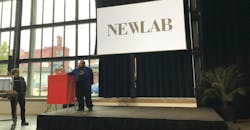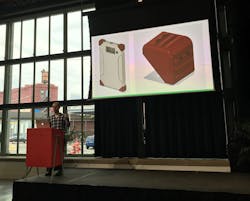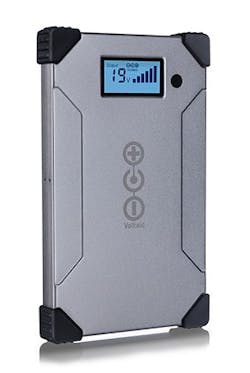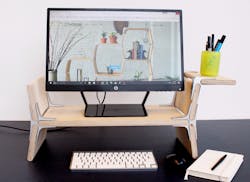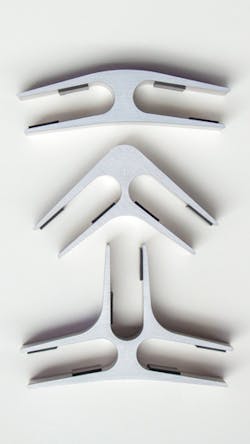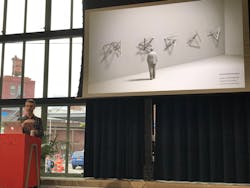New Lab is not just another building recently renovated in the Brooklyn Navy Yard. It is a community that encompasses New York City’s leading companies working in advanced technologies. The space for these innovative startups hosts a wide selection of companies, and all the tools necessary to be market leaders. Among these companies, Ultimaker has set up a U.S. base in New Lab. However, this is more than a base; it is sharing an office directly with some of its customers.
The president of Ultimaker North America, John Kawola, met me at New Lab to tell me about the new Ultimaker S5 printer. The first thing I noticed was that it’s bigger. The build space is 13 by 9.4 by 11.8 in. Also, the price is now, what I would consider, out of Maker/hobbyist range. The Ultimaker printers have increased around $1,000 per generation. The new Ultimaker S5 is around $6,000 (price will vary based on distributor). I felt at this price Ultimaker was making a statement that they are focused on the industrial market, as companies like Volkswagen, Jabil, and GE have adopted Ultimaker for prototypes, fixtures, jigs, and more.
“I would like to say this was our strategy—that we sought out these companies to partner with them—but I think it happened more organically,” says Kawola. “I think there were some engineers that used our printers at home and eventually worked one into their budget at work. Once people saw them showing up in their shops, managers started programs to use them as effectively as possible. Now we’re in all these Universities and large companies.”
The event continued, and Shayne McQuade, CEO of Voltaic Systems, a portable solar power company, shared how his company was using the new printer. It did use the Ultimaker S5 to improve the design of one of their batteries, but I was more distracted by the technology. The V88 Laptop battery from Voltaic is 24,000 mAh, but what I thought was cool was that it is optimized for solar charging. (The voltage input range of the V88 is: 14-25V.)
Another feature I thought was great and could really expand edge computing and IIoT was autonomous operation. If placed in a remote, dry area, the battery will turn itself on as soon as it has a slight charge to restart operation if it is ever fully discharged.
“Most batteries will accept a 5V charge with a little variation; maybe 4.6V or 5.3V, but photovoltaics produces a much wider voltage range. If a solar panel is producing voltages of 4 or 7 Vo, or greater variation, a traditional battery will not charge. The V88 battery has this wide voltage input range, so it’s much more efficient when charging from a solar panel” says Tony Kauffmann, product development engineer for Voltaic. The company sells solar arrays, backpacks, and kits; for more information e-mail [email protected].
The battery can also charge and discharge at the same time, so you can charge your phone while charging the battery.
The S5 produced new corner pieces to increase the strength of the battery that is designed to be used in tough outdoor applications. Voltaic was not only able to prototype the corners on the S5, but with the build space, engineers were able to print 99 corners in a single print. This means the company could offer custom corners for logos, colors, etc. for low volume production. Kauffmann also mentioned they could print an entire case if needed.
These aluminum brackets can be used with plywood to make a plethora of different types of furniture. The S5 was used for prototyping and, with some of the stronger materials, could be functional.
Next was Modos furniture that 3D printed an innovative jointing part. The modular wood furniture company needed a printer that could produce strong brackets with a tight tolerance. This jointing technique lets users reform furniture as needed.
Shelving units may become a desk, or a bed become your next dining room table. It is an interesting way to help become sustainable by making your old furniture into your new furniture.
Then, Eric Forman of Eric Forman Studios presented how he is using 3D printing in art. In one piece, Forman printed joints to connect different parts of a wooden sculpture he designed. He is an artist working with interactive installations and responsive sculpture.
This rendering is of an Illuminated wooden sculpture. The wood actually glows from the inside, and the joints not only join and hold the structure together; they also make space for the LEDs and electronics.
When asked why Ultimaker succeeded at a time when it seemed like a new 3D printing company was launched every week. In short, the company focused on its strength and tried to make the most robust user-friendly printer and software they could. Some of the features that prove this in the Ultimaker S5 are…
- Seven touchscreens to configure printer and preview prints
- Wi-Fi and USB communication
- NFC filament detection, and a filament flow sensor
- Doors – glass doors help control airflow
- Dual extruders
- Capacitive scanner – compensates for variations on the build plate and adjust Z-axis automatically
The extra connectivity and filament management lets you know what material you are printing and how much you have left. This let users know before they start a print if they have enough material on the spool to finish the upload part. The S5 can also print more materials, such as Tough PLA. “It’s all the benefits of PLA, but with the strength of ABS,” says Kawola. The event at New Lab showed not only successful applications, but some of the amazing companies that are working in the New Lab facility. To find out more about who else is at New Lab, go to https://newlab.com/members/.
About the Author

Jeff Kerns
Technology Editor, Machine Design
Studying mechanical engineering at Rochester Institute of Technology (RIT), Jeff Kerns worked in the Polymer Research Lab. Using RIT’s co-op program, he worked for two aerospace companies focusing on drafting, quality, and manufacturing for aerospace fasteners and metallurgy. He also studied abroad living in Dubrovnik, Croatia.
After college, he became a commissioning engineer, traveling the world working on precision rotary equipment. Then he attended a few master's courses at the local college and helped an automation company build equipment.
Growing up in Lancaster County, PA he always liked to tinker, build, and invent. He is ecstatic to be at Machine Design Magazine in New York City and looks forward to producing valuable information in the mechanical industry.
